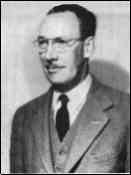
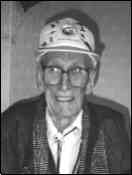
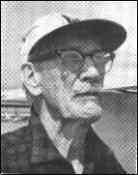
| PERCIVAL HOPKINS SPENCER 1897-1995 |
 |
 |
 |
| Percival Hopkins Spencer, 1956. | Percival Hopkins Spencer, 1994 97th Birthday. |
Percival Hopkins Spencer, 1995. |
|
By Dale L. "Andy" Anderson Spence's lineage has been traced to the Crusades. Two of his Hopkins forebears were aboard the MAYFLOWER when they landed at Plymouth Rock, one of whom signed the Mayflower Compact. Three brothers in the Spencer family arrived in 1639 with grants from the King and settled the Connecticut cities of Hartford and East Haddam. The third settled Providence, Rhode Island. Spence's grandfather, George Washington Rodgers, was a famous Clipper Ship Captain and sailed the first screw propelled, steam powered ship around the horn to San Francisco and later to Hawaii. His daughter, Georgette, married Christopher Minor Spencer and from this union, Spence was born April 30. 1897 in Windsor, Connecticut. Christopher Minor Spencer, Spence's dad was a successful inventor and is credited with invention of the automatic screw machine and the repeating rifle. He had a shooting match with President Lincoln when he demonstrated the rifle to the President because Secretary of War, Stanton, refused to talk to a "crackpot inventor." In response to quizzical expressions as Spence related the incident, he said, "Yes, it was my father, not grandfather." He then informed the audience that his father was 63 years old when he was born. The Spencer Repeating Rifle is credited as having shortened the Civil War and for deciding the battle of Gettysburg. Even as a youngster, Spence exhibited a creative mind and mechanical ability. With three feathers from his pigeon loft, he made a successful ornithopter and used this expertise later in life to market a rubber propelled model which in 1958 was adjudged one of the ten best toys of the year. Further development resulted in a motor powered version, one of which is on display in the Smithsonian Air and Space museum as a World's First. Christopher was very supportive of his son's endeavors and permitted him full use of his shop and provided an open account to purchase materials needed. When Popular Mechanics Magazine published plans for a hang glider, the youngster built one, thus providing the means to make his first solo flight April 2, 1911 at age thirteen from Prospect Hill in Keeney Park. Having a rather frail physique, he suffered skinned knees and elbows and bruised his back when landing, as he could not run fast enough with the glider slung to his shoulders. He quickly ascertained that shifting weight to obtain control was not the way to fly, so installed a three axis control system and made twin pontoons from stove pipe with soldered joints reinforced by spruce stringers. When towed behind his father's boat with 300 feet of rope and assisted by an 8 to 10 knot wind, he was able to become airborne. The drag of the glider was so great that it was forced to follow the boat and could not be cut loose as it needed the help of the boat to remain in flight. |
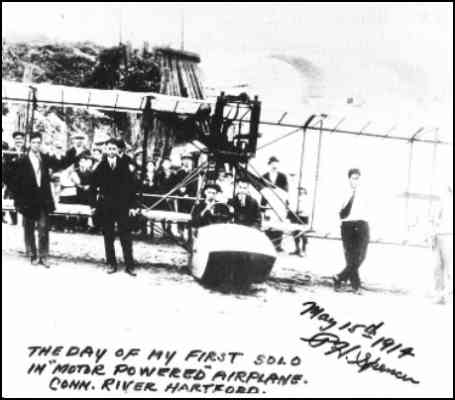 |
||
|
The day of my first solo in "motor-powered" airplane. Connecticut River, Hartford May 15, 1914, P.H. Spencer. |
|
A year or so later, a local man built a Curtiss type flying boat which crashed during take off on its first
flight, and was left on a sand bar without the engine. Spence convinced his father to purchase the wreck and proceeded to rebuild it to
flying condition. He discovered a 4 cylinder Roberts water cooled 50 horsepower, two cycle engine of aluminum construction on Long
Island which his dad financed, and soon thereafter the flying boat was ready for flight. His dad must have had unlimited faith to foster
flying by his 16 year old son a mere seven years after the Wright Brothers first flew in 1903. When completed, Spence intended to taxi
the plane across the river to a nice sand bar, but once on the river, in the exuberance of youth, he opened the throttle a little too far and
soon found himself in the air. He felt comfortable due to his previous glider experience, but soon realized he did not know how to turn
since the glider never gave him an opportunity to try. He flew down the river about five miles, landed and turned around on the water
headed back home. After getting airborne he saw the Hartford to New York night boat leaving the dock. Taking advantage of the
opportunity, proceeded to give it a buzz job, remaining at a "safe altitude", he said with tongue in cheek. People on the boat probably
never saw a plane in flight so waved hysterically as he flew by. This was Spence's first flight in a powered aircraft which was also the
first flight of the aircraft. Take off was at the foot of State Street on the Connecticut River in Hartford, May 15, 1914, just two weeks after
his 17th birthday. Shortly after this flight, he substituted tricycle landing gear for the boat and made several flights from Charter Oaks Race Track. Once, as he was banking around the track, the engine "wound down" causing the wing to make contact with the track rail pitching Spence out to miraculously land unharmed in a pile of straw used to protect the track from rains. As one would suspect, the straw was liberally sprinkled with horse droppings. When Spence crawled out of his odorous landing site, he saw the plane balanced on the ends of the four wing spars with wings perpendicular to the ground, and as he watched it teetering, a gentle breeze caused it to tilt from vertical to land on its wheels. Damage was superficial and quickly repaired. Planes of that era usually had the engine in the rear and pilots did not use safety belts as they figured it better to be thrown out than remain trapped in the wreckage with the heavy engine, propeller and possible fire. He had arranged to store the plane during winter in a tobacco barn across town, and as it was now fall, he decided it was time to do it. He took off from the race track and as he flew over a large greenhouse, the engine quit. Looking over his shoulder, he saw the magneto dangling on the spark plug wires because its bracket had broken. Fortunately, he was able to glide down a slope where the kids were tobogganing to land on a frozen pond with no damage. After welding the bracket and re-timing the engine, he was on his way to the tobacco barn. Here he made an error committed by many pilots, he landed down wind. As a result, the plane overshot the field, nosed into a wide deep ditch, and Spence was pitched out to slide down a corn field having cut stalks sticking up thru the sonow tearing his clothes with much abrasion to his young body. The tangles mess was dragged into the barn and forgotten. During 1915-1916, he used a Roberts 6 cylinder 100 horsepower engine to construct a single pontoon biplane, which waz damaged as he attempted to taxi it from a lagoon into the river. He decided to replace the pontoon with wheels and began flying from a field just north of the Hartford. A bad landing destroyed the plane and trapped Spence in the wreckage. The hot water from the engine caused severe burns until bystanders extricated him. Later in 1916, he worked for Lowe, WIllard & Fowler Engineering Corporation who built planes primarily for the Navy. In 1917, due to his expereience as a pilot and builder, he was sent to the B.F. Sturdevant Co. in Boston as an inspector of Curtiss Jenny fuselages on assignment as an employee of the Bureau of Aircraft Production, U.S. Army Signal Corps. After WW I, Spence built a three passenger, single float, seaplane powered with a Curtiss OX6 engine. Fish glue used in the construction produced a strong, offensive odor causing it to be named "Old Rotten Belly." He and his school friend, Stewart Chadwick, were successful with it, barnstorming in the New England area. In addition, he modified a Thomas Morse Scout by clipping the lower wing and substituting an OX5 engine for its original LeRhone to win a number of races. From 1922 to 1925, he became the first manager of the Hartford Airport where he owned five Avro 504 biplanes used for training, passenger rides and charters. In 1925, he formed and was president of the New England Aircraft Corp., in Hartford, CT., which was recognized as New England's largest aero sales and service organization, and was the first to obtain a WACO airplane franchise, starting with the famous WACO Nine. He sold his corporation to the Curtiss Flying Service in 1929 to remain with them as sales manager and Chief Demonstration Pilot of their New England Division. That year, using a Curtiss Robin, he established a world altitude record for light aircraft and also competed in the 1929 National Air Races at Cleveland, Ohio. From 1930 to 1934, he became Sales Representative and Chief Test Pilot for Ireland Aircraft Corp., leading producers of two to five passenger amphibians. He remained with the corporation when it was purchased by Amphibians Inc. Beginning in 1934, he flew a Ford Tri-motor for Shell Eastern Petroleum Corp. for a year, and then went to Sikorsky Aircraft Manufacturing Co. where he worked on construction and inspection of their S-43 flying boat. Soon he was offered the position of Executive Pilot for the president of Pan American Airways, which he filled until mid 1937. The desire to produce a superior amphibian led him to organize, in 1937, the Spencer/Larsen Aircraft Corp. He conceived a unique design by burying the engine inside the hull with the propeller on a shaft from the engine. He became disenchanted with corporate design policies and resigned in 1940. Immediately, he began to work on his concept of an ideal amphibian. By 1941, he had designed, built and flown his Spencer Amphibian Air Car #1, but was forced to put it in storage due to WW II restrictions to civilian flying. Later in 1943, it with its design patent was sold to and produced by Republic Aviation Corporation as the "Seabee." As test pilot for Republic Aircraft Corp. from 1941 to 1943, he made the first flight of 286 P-43 and P-47 fighter aircraft as they rolled off the production line, experiencing one miraculous escape from sure death when a gear in the propeller broke just as the wheels left the runway on takeoff. He and the plane survived because of superior pilotage, for which he was commended. When Republic decided to start production of a variant of his Spencer Amphibian Air Car #1, Spence became Design Consultant, Test and Demonstration Pilot for the Republic Seabee from 1943 to 1945. He received a royalty for each Seabee produced. From 1945 to 1953, he became semi-retired with activity in real estate development and home construction in Florida. 1955 found him back at the drafting board to design and promote his S-12B single engine amphibian and during 1956-1957, designing and promoting his S-13 twin engine amphibian which used either piston or turbo-prop engines. In 1958 he sold patent license rights on his rubber powered ornithopter to WHAMO Mfg. Co., who produced 650,000 units. He also developed the production tooling for the company and remained as consultant until 1958. This was rated as one of the ten best toys of the year by an article in Life Magazine. During 1961-1964, Spence developed the first successful gasoline engine powered ornithopter in the likeness of a seagull. The prototype is on display in the Smithsonian Institution Air & Space Museum as a world's first. He continued the project to design in detail a full scale man carrying version, which was evaluated by teams from Princeton University and Hughes Aircraft Corp., who agreed it would meet performance specification if built according to plans. A radio controlled model is on display in the New England Air Museum in WIndsor Locks, CT., to whom Spence gave all his memorabilia several years ago. He established Trident Aircraft Corp. in collaboration with C.Y. Herbst in 1965, and as a team designed the Trident Amphibian which was sold to Trident Aircraft Co., Vancouver, B.C. The name of this aircraft of outstanding performance was changed to Tri-Gull by the owners. |
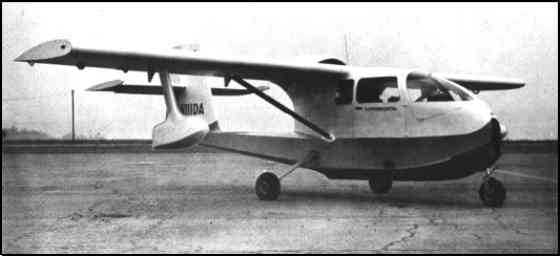 |
||
| The Spencer Air Car. |
|
In 1968, he designed and marketed with his partner, retired USAF Col. Dale L. Anderson, the 4 passenger Spencer Amphibian Air Car,
(S-12C, D, E) as home built kits. In 1980, he began design of the S-14, a two passenger Air Car, Jr. amphibian of advanced composite
construction with folding wings for highway transport. Spence was pilot on the first flight of this plane November 4, 1983 at age 86 years,
7 months, as well as being pilot on all subsequent flights totaling 38 hours. This aircraft has been donated to the Experimental Aircraft
Association Museum in Oshkosh, WI.
We recently contacted Early Bird P.H. Spencer to learn what progress he has made with his home-built amphibian airplane. He wrote us as follows: "First flight of one hour was made at Chino Airport, Cal., on May 25, 1970, and initial water tests were made at Lake Havasu on the Colorado River, July 8, 1970. Late in July, the Air Car was ready for the trip to the E.A.A. Fly-in at Oshkosh, Wis. However, we were weathered in along with others, for five days at Kansas City and missed our opportunity to demonstrate the Air Car. There were many who were expecting to see the Air Car there and we were disappointed in not arriving. We continued the tour Eastward as originally planned and made a 5,000 mile circuit via Pittsburg, Mobile, New Orleans, Houston, El Paso, Tucson and Los Angeles. Since our return home, the Air Car has been flown at West Coast Fly-ins and for local testing and demonstrations. It now has over 180 trouble-free hours of flying time including some 150 landings in salt water and thanks to the Wood Hull Construction, corrosion is not a problem. As of this date, many plans have been purchased and several of the builders are well along with construction. Col. Dale L. Anderson and myself built the Air Car in a two-car garage with the usual hobby shop tools with the exception of certain parts of the landing gear, which required machine shop equipment. It was completed in 18 1/2 months and flown two weeks later. The cost of construction was $4700.00 less engine, propellor, instruments and radio. Completed cost was $8700.00 powered with a low time 180 H.P. 0-360 Lycoming engine, constant speed Hartzell propellor and full group instrument panel with used Bendix 220-Nav/Com. Many pilots have flown the Air Car and speak highly of its fine handling qualities, especially in the water. It now is stressed for 3100 lbs. gross weight (Standard category) and 260 H.P. This will provide high lake operation capability with 1050 lbs. of useful load." When Spence retired from flying in 1987, he had been flying longer than any other person, and was believed to be the oldest licensed pilot in the United States. The Early Birds of Aviation is an exclusive group who flew solo before December 17, 1916. Of the 598 original Early Birds, Spence was one of the four remaing members Spence passed away quietly in his sleep early morning January 16, 1995 in the Del Amo Nursing Home, Torrance, California. Interment of his ashes will be in the family plot, Windsor, Connecticut. Reverend Patrick J. McPolin, a Life Member EB and long time, dear friend, eulogized Spence in a memorial service at Domingues Chapel, Rancho Domingues, CA., February 10, 1995. This was most appropriate since the Domingues Ranch Adobe, now the Domingues Seminary, was the site of the first air meet in the USA in 1910. Father Pat, with the chapel reflecting an aviation atmosphere, programmed an outstanding service. He had arranged a large easel draped in black holding a helmet and goggles and photo portrait of Spence taken about 15 years ago, just as we wished to remember him. The base of the easel was blanketed with beautiful floral tributes. Father Pat maintained the aviation theme as he officiated wearing a black leather flight jacket in lieu of his clerical robes. Following the service, there was a flyby with one of Spence's famous designs, a Seabee, in the lead. We wish that all Spence's freinds could have been present at this most memorable occasion. Thank you Father Pat. Twelve years ago, Spence attended a commemoration service for a pilot friend at Whiteman Airpark restaurant and stated he would like to have one when his time came, but believed a hangar would be a more appropriate place for fly-boys. He discussed this with a friend whose hangar is much larger than mine, and he quickly agreed to offer his for the occasion. We expect to announce the date in the very near future, hopefully, about mid March. |
|
P. H. Spencer was elected to be an Honorary Fellow of the Society in 1977. You can access this site by clicking on: P. H. Spencer You may want to use the "Find" function on "Spencer" I invite you to browse the site for other familiar names |

